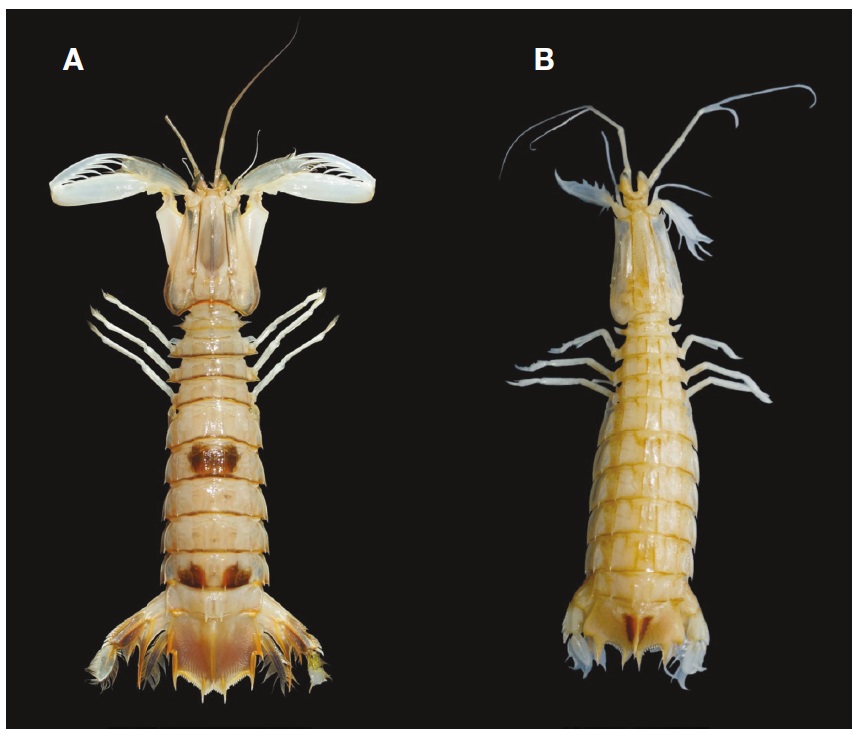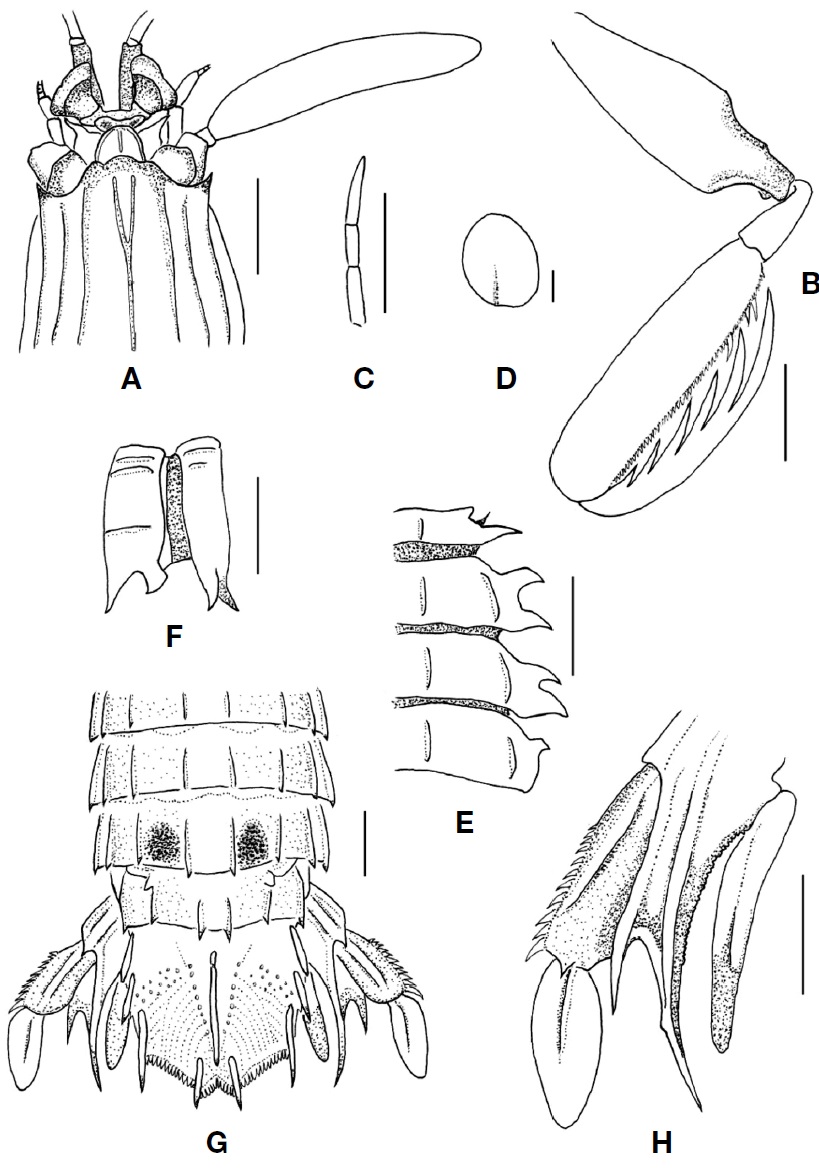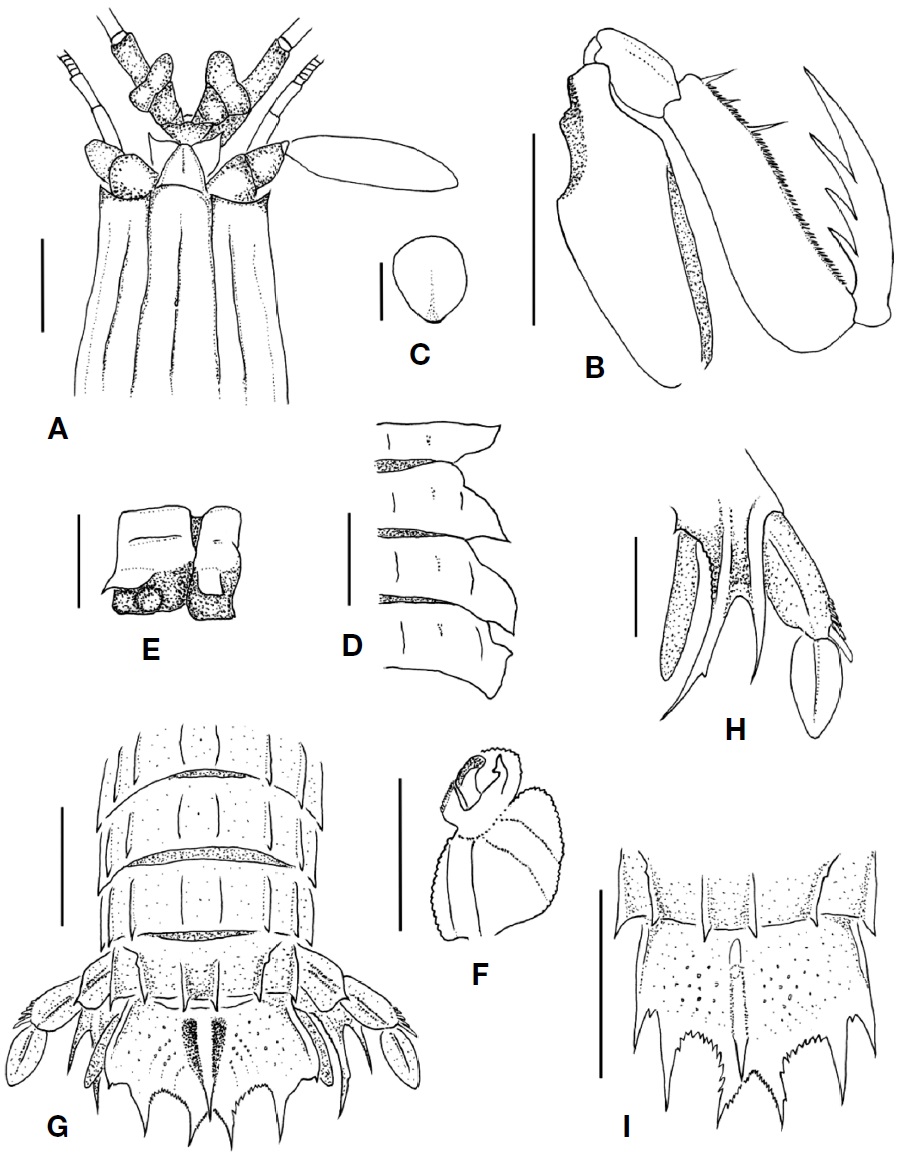



The stomatopods include more than 450 marine species in the world (Ahyong, 2001). Among them, only four species, in three superfamilies and four families, have been reported from Korean waters:
The specimens of these species were preserved in 95% ethyl alcohol and examined using Leitz zoom stereomicroscope (Leica, Wetzler, Germany) with a camera lucida. Images were obtained using a digital camera (Model E-5; Olympus, Tokyo, Japan). Digital vernier caliper (CD-15 APX; Mitutojo, Kawasaki, Japan) was used for measurement: TL (total length) was measured from the apex of the rostral plate to the apices of the submedian teeth of the telson. Morphological terminology generally follows that of Ahyong (2001). Specimens examined in this study were deposited at Silla University, Busan.
>
Material examined. Korea: 2♀♀ (TL 163-164 mm), Seogwipo port (Jejudo Island), 29 May 2015, Ko HS.
Description. Eye (Figs. 1A, 2A) small, broader than stalk, not extending to distal end of segment 1 of antennular peduncle; cornea bilobed, set obliquely on stalk. Rostral plate (Fig. 2A) broader than long; apex rounded; median carina present.
Carapace (Figs. 1A, 2A) narrowed anteriorly; dorsal surface rugose, pitted; anterolateral spines present; median carina distinct, uninterrupted at base of anterior bifurcation, branches of anterior bifurcation distinct; intermediate carina parallel to gastric groove.
Dactylus of raptorial claw (Figs. 1A, 2B) with 6 teeth on inner margin, increasing in size distally; propodus (Fig. 2B) pectinate on inner margin, with 3 movable spines on inner proximal margin; dorsal carina of carpus entire; merus without outer inferodistal spine.
Mandibular palp (Fig. 2C) 3-segmented.
Maxillipeds 1-4 each with epipod (Fig. 2D); maxilliped 5 without epipod.
Thoracic somite 5 (Figs. 1A, 2E, F) with lateral process as single slender spine directed laterally; ventral spine directed anterolaterally. Thoracic somite 6 with bilobed lateral processes; anterior lobe broad, trapezoid, with acute apex; posterior lobe triangular; incison between anterior and posterior lobe very wide. Thoracic somite 7 (Figs. 1A, 2E) with bilobed lateral processes; anterior lobe slender, with acute apex; posterior lobe broad, triangular. Thoracic somite 8 with short trapezoid lateral process.
Abdomen (Figs. 1A, 2G) with submedian, intermediate, lateral and marginal carinae; somites 5-6 with submedian carinae spined posteriorly; somites 3-6 with intermediate carinae spined posteriorly; somites 1-6 with lateral carinae spined posteriorly; somites 1-5 with marginal carinae spined posteriorly.
Telson (Figs. 1A, 2G) as broad as long; dorsal surface scattering of granules, with median carina spined posteriorly; prelateral lobe present; 3 pairs of primary teeth each with dorsal carina; submedian teeth with fixed apices on posterior margin; 1 lateral, 14-15 intermediate, 6 submedian denticles present.
Uropod (Figs. 1A, 2G, H) with slender endopod; protopod crenulated on inner margin, terminating in 2 spines, inner spine longer than outer one; proximal segment of exopod with 10-11 movable spines on outer margin, with distal spine ventrally.
Distribution. Western Indian Ocean to Vietnam, Japan, the Philippines, New Caledonia, Australia (Ahyong, 2001), Taiwan (Ahyong et al., 2009), and now Korea.
Coloration. Dorsal color in life light brown. Grooves on carapace and posterior margins of thoracic and abdominal somites dark brown. Carapace with orange posteromedian margin. Abdominal somite 2 with dark brown median patch, somite 5 with pair of dark brown patches dorsally. Telson with orange carinae. Uropodal protopod and exopod with orangish margins; proximal segment of exopod dark brown.
Remarks. Recently, the genus
>
Material examined. 2♂♂ (TL 82-88 mm), 1♀ (TL 72 mm), off Geojeodo Island (34°43.9′N, 129°01.2′E), 90 m depth, trawl, 27 May 2007.
Description. Eye (Figs. 1B, 3A) small, broader than stalk, not extending to distal end of segment 1 of antennular peduncle; cornea bilobed, set obliquely on stalk. Rostral plate (Fig. 3A) subtriangular; median carina present.
Carapace (Figs. 1B, 3A) narrowed anteriorly; dorsal surface rugose, pitted; anterolateral spines present; median carina present, without anterior bifurcation; intermediate carina shorter than and parallel to gastric groove.
Dactylus of raptorial claw (Figs. 1B, 3B) with 4 teeth on inner margin, increasing in size distally; propodus (Fig. 3B) pectinate on inner margin, with 3 movable spines on inner proximal margin; dorsal carina of carpus entire; merus without outer inferodistal spine.
Mandibular palp absent.
Maxillipeds 1-4 each with epipod (Fig. 3C); maxilliped 5 without epipod.
Thoracic somite 5 (Figs. 1B, 3D, E) with single lateral process as lobe directed laterally. Thoracic somites 6-7 each with single lateral process; anterior margin rounded, posterior margin acute. Thoracic somite 8 (Figs. 1B, 3D) with triangular lateral process.
Abdomen (Figs. 1B, 3G) with submedian, intermediate, lateral and marginal carinae; somite 6 with submedian carinae spined posteriorly; somites 3-6 with intermediate carinae spined posteriorly; somites 1-6 with lateral carinae spined posteriorly; somites 1-5 with marginal carinae spined posteriorly. Endopod of pleopod 1 (Fig. 3F) flattened, with elongated tube and hook processes in male.
Telson (Figs. 1B, 3G, I) subtriangular, slightly broader than long; dorsal surface scattering of granules, with median carina ending in strong spine; 3 pairs of primary teeth without dorsal carina; lateral teeth minute in male, but, well developed in female; submedian teeth with fixed apices on posterior margin; prelateral lobe absent; 1 acute lateral denticle present in female (Fig. 3I); 12-13 intermediate, 12-14 submedian denticles present in both sexes.
Uropod (Figs. 1B, 3G, H) with slender endopod; protopod crenulated on inner margin, terminating in 2 spines, inner spine longer than outer one; proximal segment of exopod with 6-8 movable spines on outer margin.
Distribution. Indonesia, Japan, the Philippines, Australia (Ahyong, 2001), Taiwan (Ahyong et al., 2009), and now Korea.
Coloration. Dorsal color in life light brown. Carapace grooves and posterior margins of thoracic and abdominal somites brown. Telson with pair of dark brown patches on dorsal surface.
Remarks. The genus
The secondary sexual character of the reduced and swollen lateral teeth in male telson has been reported for the Philippines and the Australian specimens by Moosa (1986) and Ahyong (2001). This character is also found in the Korean specimens.
Korean name:1*사니갯가재속 Korean name:2*사니갯가재


